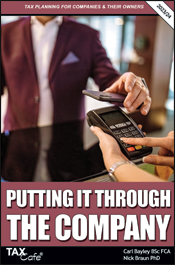Trading Losses:
How to Claim Tax Relief
Tax Relief on Trading Losses
UNDER A temporary facility, businesses may carry back trading losses over a three year period rather than the usual twelve months. For companies, the facility applies to losses in accounting periods ending between 24th November 2008 and 23rd November 2010.
The latest information can be found in our guide:
Putting It Through the Company
For sole traders and partners, the facility applies to losses arising in any period falling to be taxed in 2008/9 or 2009/10. In most cases, this means accounting periods ending between 6th April 2008 and 5th April 2010.
The new relief supplements the existing range of trading loss reliefs – perhaps adding to the confusion. So complex is the range of choices facing many loss-making businesses that professional advice is essential.
How Does the Relief Work?
Companies must set their losses off against any other income and capital gains in the same period first before carrying back any remaining balance. The remaining losses can then be set off against all income and gains in the preceding year. Under the new relief, up to £50,000 of any balance still remaining after this can also be carried back to the previous year and, if any is still left, to the one before that.
Under existing rules, individuals with trading losses may claim to set them off against all their income in the same tax year and/or the preceding year. A claim under this provision must be made first before any claim under the new relief.
If relief has so far only been claimed against current year income, the first step under the new relief is to set the remaining losses against trading income of the preceding tax year. After this, up to £50,000 of any balance still remaining can be carried back and set off against trading income (and only trading income) of the previous year and, if any is still left, of the year before that.
The £50,000 Cap
As we can see, after the usual one year carry back, the new relief is capped at £50,000. For companies, this cap applies separately to losses in periods ending during the year to 23rd November 2009 and losses in periods ending during the following year. The cap is also reduced pro-rata for accounting periods of less than twelve months.
Careful planning may therefore be needed to make the most of the new relief.
Delgado Limited made losses of £15,000 in the year to 31st December 2008 and expects to make losses of £200,000 in the following year. As things stand, only £50,000 of the second year’s losses can be carried back.
Let us suppose, however, that Delgado draws up accounts for the six months to 30th June 2009 and these show a loss of £100,000. Up to £25,000 of this loss can now be carried back in addition to up to £50,000 of losses arising in the year ended 30th June 2010.
For sole traders or partners, the cap applies separately to losses arising in 2008/9 and 2009/10.
Roger made a trading loss of £5,000 in the year ended 30th June 2008 which falls into 2008/9. He expects to make a loss of £100,000 the following year which will fall into 2009/10. As things stand, only £50,000 of the second year’s losses may be carried back under the new relief.
Roger therefore decides to draw up accounts for the six months ended 31st December 2008. These show a loss of £45,000, which falls into 2008/9, bringing the total losses of that tax year qualifying for the new relief up to £50,000. Roger will still be able to carry back up to £50,000 of trading losses arising in 2009/10.
Making a Claim
Companies must complete their tax return for the loss-making period in order to make a claim under the new relief.
Individuals do not need to wait until their tax return is due, however, and may make an immediate stand-alone claim as soon as they have calculated their losses for the relevant period. Simply write to your Tax Office, specifying the name of your business, the period for which the loss was made, the amount of the loss, and the details of how the loss is to be set off.
Difficult DilemmasA company has a loss of £100,000 for the year ended 31st March 2009 which it could carry back against profits of £50,000 arising in both of the two previous years. This would generate repayments totalling £19,500, as the company would have paid Corporation Tax at 19% and 20% in 2007 and 2008 respectively.
After breaking even in 2010, the company bounces back strongly and is forecasting profits of £400,000 for the year ending 31st March 2011. £100,000 of this profit will be taxed at a marginal rate of 29.5%, meaning that carrying 2009’s loss forward would save £29,500.
It’s a tough choice but, at times like these, cash is king and the company may need £19,500 now far more than it needs £29,500 in a couple of years. It’s a case of ‘a bird in the hand’ versus ‘two in the bush’!
Sole traders or partners could face an even worse dilemma. Losses which produce repayments at rates of 22% or less when carried back might produce tax relief at up to 61.5% when carried forward.




